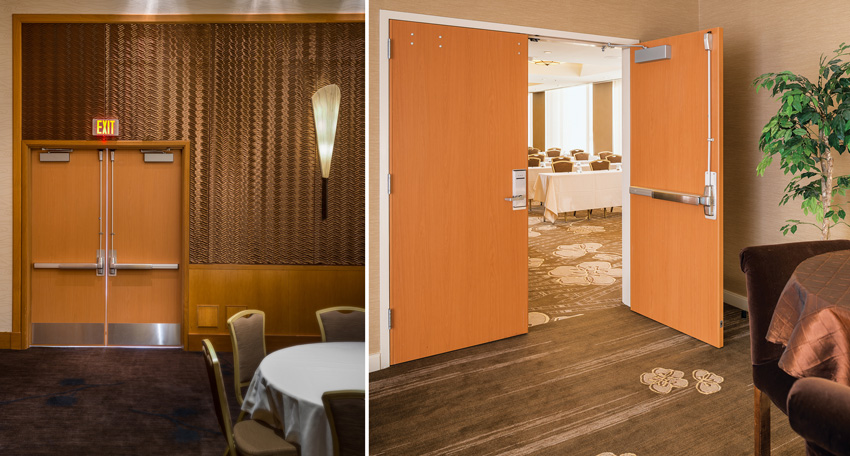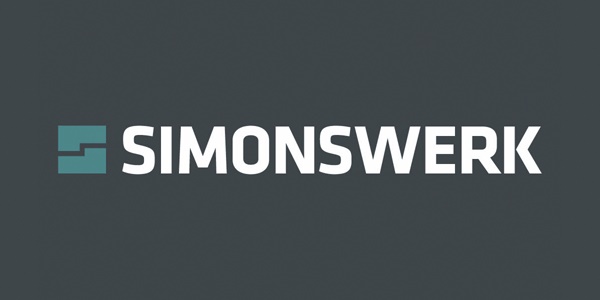This CE Center article is no longer eligible for receiving credits.
Durable and Attractive Doors
In the design of hospitality and retail facilities, doors and entrances play a significant role both in terms of design and performance in many different locations. Typically, architects need to be able to address doors and entrances in any or all of the following areas:
- Front entrances
- Guest rooms
- Stairwells
- Corridors and hallways
- Ballroom and banquet rooms
- Kitchens
- Mechanical rooms
- Fitness centers and spas
- Loading docks and storage rooms
Each of these locations may have different design criteria. Front entrances, for example, need to be inviting and possibly speak to the branding message, but they also need to be functional and durable. Interior doors need to work with an overall design scheme but hold up to the rigors of heavy use. Other doors may need to meet particular needs for fire resistance, security, or even blast resistance. Of course, the doors need to fit the design of the spaces they are serving, the energy conservation needs of a building envelope, and the project budget. Toward those objectives, there are choices in types of doors to select.
Aluminum, FRP, and Hybrid Doors
Recognizing the differing requirements for different types of doors, manufacturers offer a range of products to suit those differing conditions. Some of the most durable door products are made from proven, durable materials such as aluminum, fiberglass-reinforced polymer (FRP), and stainless steel. Among the most used in retail and hospitality buildings are the following:
- Aluminum entrances: Aluminum has long been a common choice for monumental stile and rail doors for front entrances and many hallways. Such doors can provide a look of distinction and incorporate plenty of glass for visibility and daylighting. Some offer tie-rod construction for flexural strength and engineered construction that results in exceptional durability and thermal properties.
- Flush aluminum, FRP, and hybrid doors: For interior hospitality and retail doors, there are variety of choices, including flush aluminum doors, hybrid aluminum and FRP doors, or all fiberglass doors. Flush-door finishes can include aluminum skins, woodgrain finishes, or all fiberglass construction. The aluminum/FRP hybrid type is a heavy-duty door for high-use applications with a maintenance-free long life expectancy. It is available in numerous stock or custom colors and is extremely flexible in terms of glazing options and hardware.
- Fire-resistance-rated doors: When fire-rated doors are required by code, composite doors made from FRP and stainless-steel construction with mineral cores are a durable option. They offer tested and approved fire ratings from 20 minutes to 90 minutes.

Photos courtesy of Special-Lite, Inc.
Different locations in hospitality and retail settings can require different types of doors made from a variety of durable materials and finishes.
The key factor for product performance in any of these choices is third-party testing. All specified or selected doors should be tested by an independent testing lab based on the applicable national standards. The manufacturers should then make the results publicly available and offer them to the architect as a submittal of proof of performance. In this way, the testing verifies any marketing claims and assures the architect and owner of performance to meet the design criteria. Such criteria may include product durability or life cycle, energy efficiency and sustainability, extreme weather resistance, sound control, fire resistance, blast mitigation and ballistic resistance, and intruder resistance.
In terms of design, aluminum and FRP products offer a broad range of choices. Multiple smooth and textured finishes are available along with numerous stock and custom colors. There are also virtually unlimited hardware choices, including custom branded or identity hardware. Glazing can be standard or custom in terms of shape, size, and type of glazing. All these factors enable considerable design flexibility, particularly since every door can be made to order.
Ben H. Dorsey III is the manager of marketing and communications with Special-Lite, Inc. He has worked with design teams on a variety of levels and says, “I do not envy the architect in terms of the breadth of knowledge he or she must have to meet the variety of client expectations and regulations in the retail and hospitality arenas. The manufacturer’s goal is to serve as a reliable source of information as well as outstanding products to make the architect’s daunting task achievable.” His colleague, Roger J. Stempky, vice president of sales and marketing at Special-Lite, Inc., offers an example: “Our primary focus is Division 8 products for openings. Retail and hospitality facilities have a variety of openings, and I see some similarities in these venues. For instance, monumental doors with a good deal of glass are often used for front entrances. Meanwhile, flush doors that can tolerate high cycle counts and even some abuse are needed elsewhere in both markets.” Both of these men reinforce the concept that recognizing the different facility needs and working with manufacturers to understand the different capabilities of different products can provide the best overall outcomes for a project.
Clad Doors
Many interior doors in hospitality and retail buildings are selected based on using a solid core construction with a cladding and edging of different types. Selecting a high-performance, highly durable clad door system will help assure they not only perform well but also look great, holding up to daily use and potential abuse. In that regard, there are several qualities to look for:
- Doors that are specifically manufactured for high-impact areas and are clad with ultra-
durable coverings for demonstrated protection.
- Attention to door edges, since that is where most door damage occurs. Some are specifically manufactured to feature rounded, field-replaceable stiles and edges for extra protection. Better yet, some carry a warranty against damage for the lifetime of the door.
- The covering on doors and frames can be specified to be bacterial- and fungal-resistant and easily cleanable with non-abrasive cleaners.
- Some doors are made of PVC-free material, can be Cradle-to-Cradle Certified, and help to contribute toward LEED v4 credits.
While all of these attributes help with the performance of the door, designers no longer have to sacrifice aesthetics for durability. They are available in a broad range of colors and patterns, including solid colors, woodgrain patterns, and various panel designs. In addition to these extensive standard design choices, some products also allow architects to display any image, pattern, photograph, etc. on a door without compromising durability.
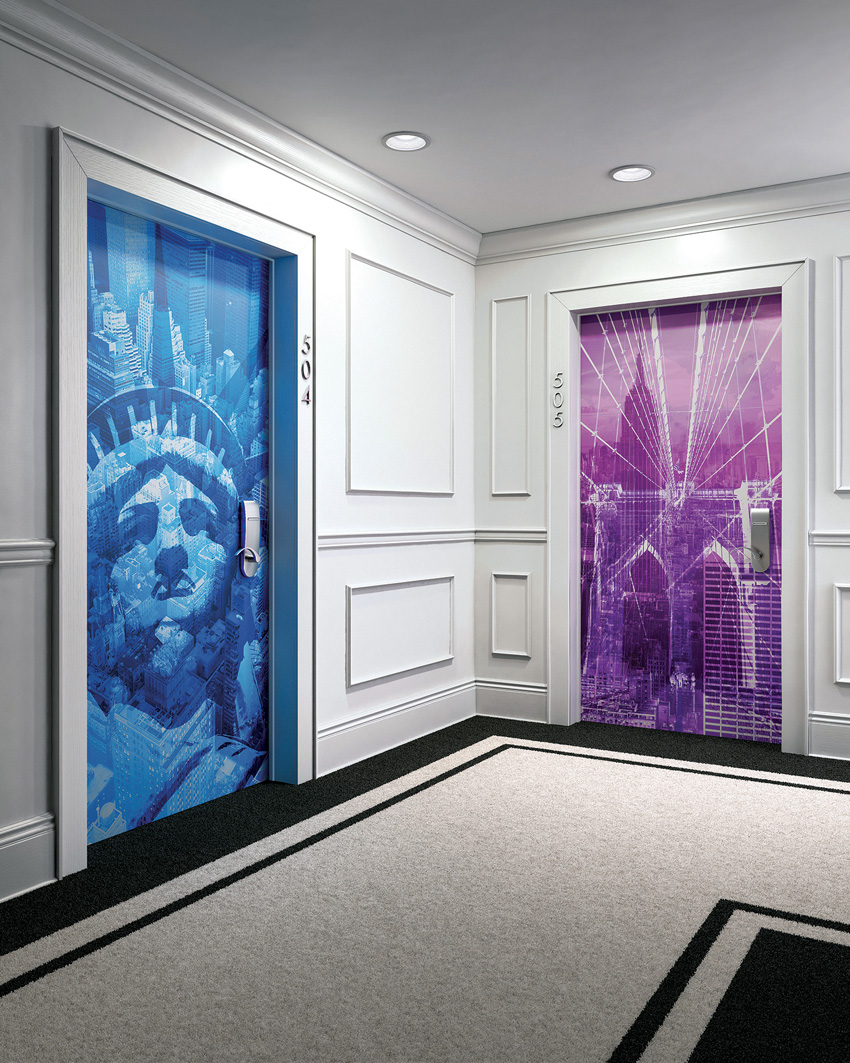
Photo courtesy of Construction Specialties
Clad solid core doors can be specified to maintain protection against abuse, include field-replaceable stiles and edges, provide sound control, and include other attributes like custom graphics, as shown here.
Concealed Door Hardware
One of the design trends in retail and hospitality settings is for sleek, elegant, and clean surface appearances. That has come to include the use of trimless doors that visually disappear to look as though they are part of the surrounding wall. To pull that off successfully, the doors need to be clad with the same material as the walls, which is clearly quite possible. It also means that the hardware, particularly the hinges, used for such doors must be hidden from sight. That is where manufactured concealed hinge systems for cladding come into play.
State-of-the-art concealed hinge systems are available for doors with cladding, where in the past it was only possible to use pivots to hang such doors. These concealed hinges allow a door to visually disappear into a wall with many different kinds of cladding, such as laminates, that are up to 20 millimeters (¾ inch) in thickness. This gives architects and designers new opportunities for incorporating closed door panels into a holistic room concept. Further, concealed hinge systems allow doors to open up to a full 180 degrees, thus providing some significant design options when the doors are open as well.
Adjustable, concealed door hinges allow a contemporary space to retain clean lines, undisturbed by an obtrusive service door in a common area of a hospitality environment, such as a lobby or ballroom. The refined visual appearance in combination with maintenance-free slide bearings means they help doors operate as good as they look. Durability is another notable trait of concealed hinges whether they are used in low-traffic door applications or for high-use doors in hotels, resorts, and restaurants. Concealed hinge systems specified with an adjustment feature typically install easier than those without. The adjustment feature provides a simple way to maintain a perfect margin between the door and the surrounding frame. Adjustments can commonly be made in three dimensions (horizontal, vertical, and in/out) by simply turning an Allen wrench. A completely concealed hinge system typically accepts load capacities up to 300 kilograms (661 pounds), enables an opening angle of 180 degrees, and can be used on wood, steel, and aluminum doors and frames. All of this means that concealed hinge systems can be used on a wide variety of retail and hospitality doors.
In order to accommodate the full range of needs for different door types and their specific locations, consider that there are different versions of concealed hinges that can be selected. Some of the most common are listed as follows:
Standard concealed hinges: Standard concealed hinges allow the door hinges to be hidden when the door is closed while still opening the full 180 degrees.
Concealed hinges for doors with cladding: These specific hinge systems allow a door to visually disappear into a wall with many different kinds of claddings, such as mirrors, laminates, and marble. This gives designers further options for integrating the door element into a holistic room concept.
Electrified concealed hinges: Modern and efficient buildings often require the ability to control and operate doors remotely. That often means that additional items such as card readers, access and door control systems, electrified locks, monitoring systems, and multimedia components are installed. These components require the transfer of electrical power and information from door frames to door panels. Concealed hinge systems that accommodate the needed wiring for electricity or data provide a sophisticated way to utilize any or all of this technology. Further, the needed wiring to carry electricity and/or data can be completely concealed behind the hinge arms to prevent unauthorized tampering. Wire-accommodating hinges are available in a large variety of sizes to suit different door panel weights.
Fire-resistant hinges: Certain models of concealed hinges are fire-resistant certified for up to 180 minutes. While maintaining all routing dimensions and visual features of standard concealed hinges, fire-resistant versions provide an option for use on fire resistant door units.
Recessed frames: Specific models of concealed hinges allow doors to be flush with the finished wall by hiding frames and recessing them into the wall structure. This provides a contemporary flush finish door and frame with clean, unobstructed lines.
Aluminum door profiles: Concealed hinges are also available for aluminum door panels and frames. There are a variety of options for different profile designs that can be selected to suit a particular project need.
Overall, architects have many choices when it comes to using high-performance, durable, concealed hinges. Creative options are not limited since fully functional, visually disappearing doors can now accommodate a wide range of needs and almost any type of cladding of up to ¾ inch thick.
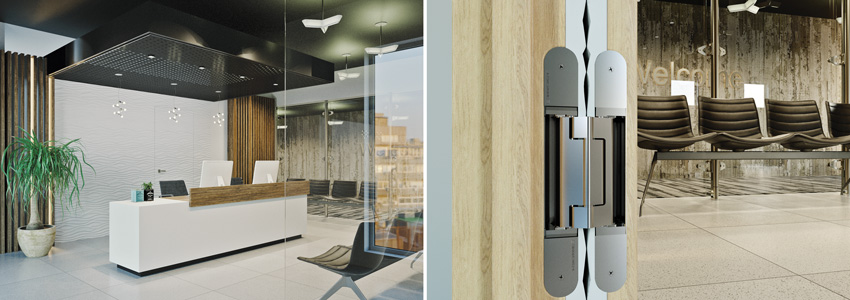
Photos courtesy of SIMONSWERK North America
Fully functional doors, clad to match adjacent walls, can benefit from the most advanced concealed hinges that allow doors to visually disappear into a wall expanse.
Rudy Kessler, CEO of SIMONSWERK North America, sees this design trend first hand and points out, “In today’s architecture, interior designers and architects are driven by the demand for contemporary and clean designs without sacrificing the functionality of a building. Typically, doors are viewed as an interruption of clean lines. Hardware companies have been challenged to come up with creative solutions for fully functional doors, especially doors with cladding, which do not disturb the design.” Recounting the development of concealed hinges, he continues, “Initially, hardware companies developed products such as concealed door hinges that hid only the hardware. More recently, hardware companies took another step forward and developed innovative solutions for hiding not only hardware, but also fully functional doors that visually disappear within the wall.” Clearly, the opportunities for clean, modern, and elegant spaces has increased due to the availability of these advanced hardware systems.
Retail and hospitality buildings are an integral part of any developed area. It is hard to imagine any urbanized area without shops, stores, restaurants, hotels, inns, and the like to both attract and serve people. Designing those spaces requires an understanding of the needs of the owners or tenants and the trends or forces that are moving the market. It also means understanding the types of products and materials that are best suited to hold up to the rigors of heavy use and high volumes of people. While it is easy to focus on the appearance and branding aspects of hospitality and retail spaces, it is equally important to recognize the need for paying attention to the durability and reliability aspect of many of the functional needs of these buildings and facilities too. That includes the public areas where people form their first impressions, but it also includes some of the behind-the-scenes areas or back-of-house spaces. All of these spaces need to be attractive, comfortable, durable, and functional in order for the staff to carry out its work and for customers to have a positive and pleasurable experience.
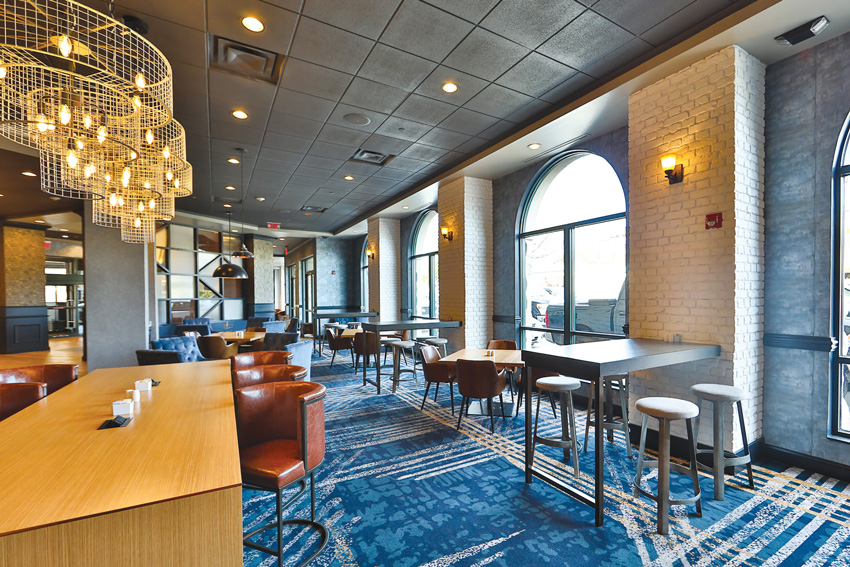
Photo courtesy of Construction Specialties
Durable materials and products combined with strong design appearances are significant factors in retail and hospitality projects, including the Hilton Garden Inn renovation in Savanah, Georgia, shown here.
With the above in mind, we will look at several areas where careful review and selection of products and materials can help promote the intended customer experiences, achieve high levels of good design, and provide high degrees of performance and durability to help assure that retail and hospitality spaces work as intended not just on opening day but for the planned life of the spaces too.
Public vs. Back-of-House Spaces
It is commonly acknowledged that the public areas of a hospitality or retail facility are typically where most of the effort and money are spent in both design and maintenance. The common mindset is that the front of the house is where the guests, patrons, or diners will spend their time (and money) and evaluate it as part of their overall experience. This is valid and appropriate, it and deserves appropriate attention. But equal attention is due to the back-of-house places, such as kitchens, service corridors, employee lounges, administrative offices, loading docks, storage, and similar locations.
The back-of-house areas are typically where the actual work of the business is conducted. For a restaurant, it’s the kitchen; for a hotel, it’s the administrative or catering office or laundry; in many retail facilities, it’s the storage areas and receiving docks.
Depending on the size of the facility and the time of day, these spaces can be the focus of a great deal of activity, some of which may not be very kind or forgiving to the building walls, floors, doors, or other surfaces.
Recognizing these demands, building designers must not only consider aesthetics and design appearance when selecting materials and finish products, but they must also consider durability and the impact of their selections beyond first costs. It usually falls to the architects to act as the holistic champions for the appearance and performance of the entire facility—both front of house and back of house. Sometimes, though, improperly executed “value engineering” is undertaken to reduce first costs, which can then take its toll six to 12 months after the ribbon cutting. Corners that are cut through the selection of “cheaper” materials or the outright elimination of key products eventually show up through damage or vandalism. Then the property’s general manager or chief engineer has no choice but to find money in their operating budget to install new products to replace broken/torn ones or fix damage—all of which would likely have been less expensive to have installed in the first place during the construction or renovation of the facility.
Rigid Wall Protection
What type of products are most affected by heavy use in retail and hospitality buildings? First and foremost are walls that see repeated daily use. The best approach here is to provide protective products over gypsum board or other walls in order to handle impacts, resist scuffing and scraping, and still be decorative enough to fit with an intended design scheme. Moderate-duty rigid wall panels, corner guards, and bumpers make sense in many locations. Heavy-duty protection products such as diamond plate wall covering, wall and floor bumpers, door frame protectors, and expansion joint covers are appropriately used in corridors and back-of-house applications where carts and other equipment move. It is worth noting that such corridors often include customer restrooms and may act as a passageway from back-of-house areas. It’s these transition zones that are often overlooked in design and planning, and end up looking worn and battered within months of the grand opening. In this case, a bit of protective forethought will keep these areas looking new and undamaged. However, adding protection doesn’t mean that design needs to suffer. Woodgrain rigid vinyl sheet, stainless steel, and 3-D trim boards have been used extensively in renovating food service and dining areas of hotels, restaurants, and retail facilities. Having a choice in materials can deliver the warmth and aesthetic of wood or the cleanliness of stainless steel yet will easily stand up to the daily wear and tear that’s inherent in any hospitality facility.
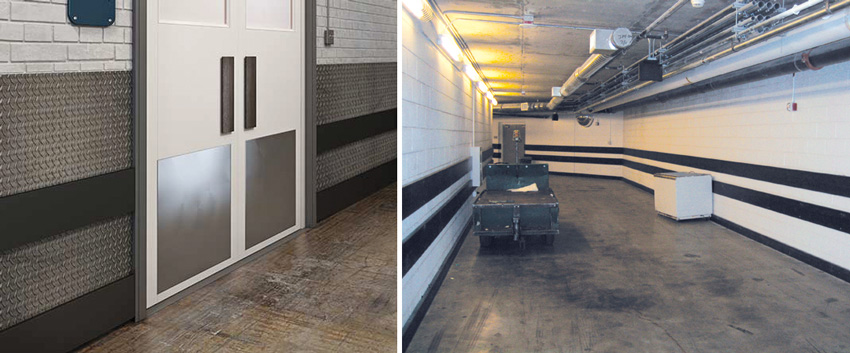
Photos courtesy of Inpro Corporation
Durability of back-of-house areas often depends on the use of protective products, such as rigid sheet applied as a wainscot, horizontal guards, and door kick plates, all as shown here.
When addressing wall designs, there may also be the need or desire to include graphics in the form of photos, logos, information, teaching, or wayfinding. Protecting such graphics as well as the wall can be a challenge in high-use areas, but the use of digitally printed, clear plastic wall panels has emerged as a truly viable wall surface option for many buildings. Printing the image on the back side of a tough, durable clear plastic sheet means that the image is protected by the clear covering. If the exposed surface becomes dirty or is bumped, the plastic takes the hit, not the graphic image. That means the imagery can take the abuse of luggage, shopping baskets, carts, strollers, purses, and other common wall hazards in retail and hospitality settings. Such a flexible but durable approach to wall protection allows any designer’s vision for a space to come to life while truly enhancing a building’s interior.
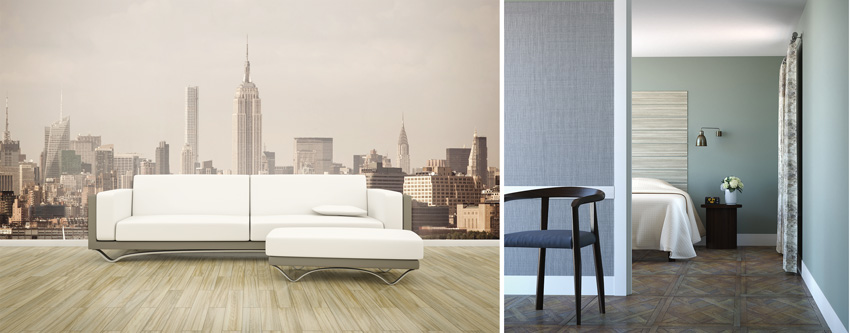
Photos courtesy of Inpro Corporation
Continuous wall protection can be used with digitally printed, clear plastic wall panels as a viable wall surface option for many buildings (left). Flexible wall protection products offer the same durability and protective performance as traditional rigid wall protection but is indistinguishable in appearance from vinyl wall covering (VWC)(right).
Flexible Wall Protection
Protecting wall surfaces from damage while still meeting interior design needs can sometimes be an ongoing challenge in retail and hospitality settings. While some rigid plastic protective wall cladding products are available that offer a patterned look, they may not always match what is being sought for a design scheme. Others offer the more varied look of contract wall covering with some protection characteristics but lack the ultra-durable performance of rigid plastics. Until now, this conundrum left architects and interiors designers in limbo, especially since certain spaces need the added protection but did not lend themselves to the aesthetic of rigid wall cladding. However, a brand new class of materials called flexible wall protection is showing great potential to be a true game changer by combining the appealing look of contract wall covering with the durability of rigid wall protection—walls can now make an impact while being able to take the impact.
Flexible wall-protection products are durable enough to handle the conditions of harsh environments yet are literally flexible enough to become the showpiece or the backdrop of an interior design scheme. With a professional, seamless installation, they can become an uninterrupted finish with an intentional texture pattern to enhance the design. They also fend off stains and vandalism, simply by wiping with standard cleaning agents, although the amount of effort needed to remove the stain or mark will vary based on the texture selected.
Flexible wall protection is quite appropriate for retail and hospitality facilities, particularly since most have some areas that are prone to be constantly bashed and slammed. If this causes damage, particularly in a public space, management will not want to leave it looking in disrepair, so someone on the staff is usually assigned to repair these problem areas repeatedly. There’s a more-subtle form of damage, however, that often accumulates slowly but eventually leads to a shoddy appearance, namely scuffs and abrasions. For example, a heavily loaded suitcase rubbing along a hotel corridor wall may not be enough to damage drywall, but it creates enough contact to leave marks, scuffs, and rubs. When this happens dozens if not hundreds of times a month, the walls soon start looking quite different from the design intent. Flexible wall protection can provide a solution to this problem by remaining intact, masking any damage to drywall behind it, removing the urgency of a repair, and containing any gypsum dust from being released into the building. In all, it is a preferred solution over vinyl wall covering or other finish options for many wall surfaces.
Masonry-Look Wall-Panel Protection
An option for wall-panel protection includes a high-quality masonry-alternative wall panel made with real stone ingredients. It uses a crushed stone surface made from natural minerals that is molded and laid over a layer of high-density foam to create a lightweight stone panel. This produces an artistic focus on detail and authenticity while feeling cold to the touch, just like natural stone. These decorative stone wall panels are resistant to rain, snow, UV damage, heat, freezing, and defrosting with no water absorption. This makes them suitable for both interior and exterior installations with the added benefit of excellent dimensional stability.
The available choices of this type of decorative wall panel include texture and qualities in different patterns that emulate brick and stone in traditional and contemporary styles. Retail and hospitality brands can choose the patterns and colors best suited for the design of their space or emulate the architecture or aesthetic in the local surrounding community. Installation is based on an interlocking edge system that enables any contractor to perform a fast, accurate, and ultimately high-quality finished surface. The average panel weight is 10–15 pounds and covers about 11 square feet. The solid, durable surface is easy to clean, maintain, and repair as needed, all of which saves the building owner time and money throughout the product lifecycle.

Photos courtesy of Construction Specialties
Decorative wall panels that emulate the appearance of painted brick are used behind the counter in this retail setting (right). Custom graphics of all types can be provided behind a clear protective wall covering to display artwork, signage, or artistic or even wall covering patterns (left).
Karen A. Jenkins, AIA, vice president of Design Continuum Inc., has direct experience with this approach in a recent project. She notes that the decorative wall panels that emulate brick are “a great, cost-effective material to reinforce the historic, industrial character we were striving to create for the interior renovation of the Hilton Garden Inn Hotel within the historic district of Savannah. The look of the brick is authentic, which is important when you are in a historic setting, and the installation was quick and easy, which meant less down time for the hotel during renovation. It added a rich texture and pattern to set the industrial train station vibe within the hotel lobby.”
Graphic Wall-Covering Protection
Sometimes, there is an interest in increasing the life cycle of interior walls and surfaces while still maintaining brand image. Further, visual merchandising is a critical component in successful retail and hospitality marketing. However, retailers and restaurateurs often have to position wall graphics above the reach of customers or risk the chance of damage and replacement. Now there are readily available products that combine custom graphic capabilities within an ultra-durable wall-protection system. This provides a unique protective wall covering that creates a sense of place, enriches the brand story, and shapes guests’ experiences. Because it is resistant to wear and damage, it is a great solution for the high-traffic spaces in retail, restaurant, and hotel environments.
Using this type of system, photographs, logos, patterns, and other graphics can be safely embedded behind a clear rigid sheet that serves as a protective shield for digital imagery while providing impact-resistant wall protection. It is available in a 0.040-inch thickness and in 4-by-8-inch, 4-by-10-inch, and custom sizes. Specifications can be written for PVC and PBT-free material with no harmful chemicals to protect customers as well as the interior. Further, it can be installed using a water-based mastic adhesive. The end result is a safe, nearly indestructible graphic that enlivens a retail, restaurant, or hospitality space.
Sarah A. Curtis, AIA, CDT, LEED AP ID+C, a senior associate in the Retail | Service division of A/E firm Little, comments on the use of this type of protective wall graphic system: “This is a product that we were excited to use on a small renovation project. We wanted to provide a branded wall with custom graphics, and this product allowed us to create a custom image with the client’s brand colors and logo for a great price. Small projects often have difficulty getting anything custom because we don’t have the square footage to warrant custom costs. We didn’t have that issue with this product. The image looked great and provided a durable solution for the result we envisioned. I look forward to using it again on future projects.”
Durable and Attractive Doors
In the design of hospitality and retail facilities, doors and entrances play a significant role both in terms of design and performance in many different locations. Typically, architects need to be able to address doors and entrances in any or all of the following areas:
- Front entrances
- Guest rooms
- Stairwells
- Corridors and hallways
- Ballroom and banquet rooms
- Kitchens
- Mechanical rooms
- Fitness centers and spas
- Loading docks and storage rooms
Each of these locations may have different design criteria. Front entrances, for example, need to be inviting and possibly speak to the branding message, but they also need to be functional and durable. Interior doors need to work with an overall design scheme but hold up to the rigors of heavy use. Other doors may need to meet particular needs for fire resistance, security, or even blast resistance. Of course, the doors need to fit the design of the spaces they are serving, the energy conservation needs of a building envelope, and the project budget. Toward those objectives, there are choices in types of doors to select.
Aluminum, FRP, and Hybrid Doors
Recognizing the differing requirements for different types of doors, manufacturers offer a range of products to suit those differing conditions. Some of the most durable door products are made from proven, durable materials such as aluminum, fiberglass-reinforced polymer (FRP), and stainless steel. Among the most used in retail and hospitality buildings are the following:
- Aluminum entrances: Aluminum has long been a common choice for monumental stile and rail doors for front entrances and many hallways. Such doors can provide a look of distinction and incorporate plenty of glass for visibility and daylighting. Some offer tie-rod construction for flexural strength and engineered construction that results in exceptional durability and thermal properties.
- Flush aluminum, FRP, and hybrid doors: For interior hospitality and retail doors, there are variety of choices, including flush aluminum doors, hybrid aluminum and FRP doors, or all fiberglass doors. Flush-door finishes can include aluminum skins, woodgrain finishes, or all fiberglass construction. The aluminum/FRP hybrid type is a heavy-duty door for high-use applications with a maintenance-free long life expectancy. It is available in numerous stock or custom colors and is extremely flexible in terms of glazing options and hardware.
- Fire-resistance-rated doors: When fire-rated doors are required by code, composite doors made from FRP and stainless-steel construction with mineral cores are a durable option. They offer tested and approved fire ratings from 20 minutes to 90 minutes.

Photos courtesy of Special-Lite, Inc.
Different locations in hospitality and retail settings can require different types of doors made from a variety of durable materials and finishes.
The key factor for product performance in any of these choices is third-party testing. All specified or selected doors should be tested by an independent testing lab based on the applicable national standards. The manufacturers should then make the results publicly available and offer them to the architect as a submittal of proof of performance. In this way, the testing verifies any marketing claims and assures the architect and owner of performance to meet the design criteria. Such criteria may include product durability or life cycle, energy efficiency and sustainability, extreme weather resistance, sound control, fire resistance, blast mitigation and ballistic resistance, and intruder resistance.
In terms of design, aluminum and FRP products offer a broad range of choices. Multiple smooth and textured finishes are available along with numerous stock and custom colors. There are also virtually unlimited hardware choices, including custom branded or identity hardware. Glazing can be standard or custom in terms of shape, size, and type of glazing. All these factors enable considerable design flexibility, particularly since every door can be made to order.
Ben H. Dorsey III is the manager of marketing and communications with Special-Lite, Inc. He has worked with design teams on a variety of levels and says, “I do not envy the architect in terms of the breadth of knowledge he or she must have to meet the variety of client expectations and regulations in the retail and hospitality arenas. The manufacturer’s goal is to serve as a reliable source of information as well as outstanding products to make the architect’s daunting task achievable.” His colleague, Roger J. Stempky, vice president of sales and marketing at Special-Lite, Inc., offers an example: “Our primary focus is Division 8 products for openings. Retail and hospitality facilities have a variety of openings, and I see some similarities in these venues. For instance, monumental doors with a good deal of glass are often used for front entrances. Meanwhile, flush doors that can tolerate high cycle counts and even some abuse are needed elsewhere in both markets.” Both of these men reinforce the concept that recognizing the different facility needs and working with manufacturers to understand the different capabilities of different products can provide the best overall outcomes for a project.
Clad Doors
Many interior doors in hospitality and retail buildings are selected based on using a solid core construction with a cladding and edging of different types. Selecting a high-performance, highly durable clad door system will help assure they not only perform well but also look great, holding up to daily use and potential abuse. In that regard, there are several qualities to look for:
- Doors that are specifically manufactured for high-impact areas and are clad with ultra-
durable coverings for demonstrated protection.
- Attention to door edges, since that is where most door damage occurs. Some are specifically manufactured to feature rounded, field-replaceable stiles and edges for extra protection. Better yet, some carry a warranty against damage for the lifetime of the door.
- The covering on doors and frames can be specified to be bacterial- and fungal-resistant and easily cleanable with non-abrasive cleaners.
- Some doors are made of PVC-free material, can be Cradle-to-Cradle Certified, and help to contribute toward LEED v4 credits.
While all of these attributes help with the performance of the door, designers no longer have to sacrifice aesthetics for durability. They are available in a broad range of colors and patterns, including solid colors, woodgrain patterns, and various panel designs. In addition to these extensive standard design choices, some products also allow architects to display any image, pattern, photograph, etc. on a door without compromising durability.

Photo courtesy of Construction Specialties
Clad solid core doors can be specified to maintain protection against abuse, include field-replaceable stiles and edges, provide sound control, and include other attributes like custom graphics, as shown here.
Concealed Door Hardware
One of the design trends in retail and hospitality settings is for sleek, elegant, and clean surface appearances. That has come to include the use of trimless doors that visually disappear to look as though they are part of the surrounding wall. To pull that off successfully, the doors need to be clad with the same material as the walls, which is clearly quite possible. It also means that the hardware, particularly the hinges, used for such doors must be hidden from sight. That is where manufactured concealed hinge systems for cladding come into play.
State-of-the-art concealed hinge systems are available for doors with cladding, where in the past it was only possible to use pivots to hang such doors. These concealed hinges allow a door to visually disappear into a wall with many different kinds of cladding, such as laminates, that are up to 20 millimeters (¾ inch) in thickness. This gives architects and designers new opportunities for incorporating closed door panels into a holistic room concept. Further, concealed hinge systems allow doors to open up to a full 180 degrees, thus providing some significant design options when the doors are open as well.
Adjustable, concealed door hinges allow a contemporary space to retain clean lines, undisturbed by an obtrusive service door in a common area of a hospitality environment, such as a lobby or ballroom. The refined visual appearance in combination with maintenance-free slide bearings means they help doors operate as good as they look. Durability is another notable trait of concealed hinges whether they are used in low-traffic door applications or for high-use doors in hotels, resorts, and restaurants. Concealed hinge systems specified with an adjustment feature typically install easier than those without. The adjustment feature provides a simple way to maintain a perfect margin between the door and the surrounding frame. Adjustments can commonly be made in three dimensions (horizontal, vertical, and in/out) by simply turning an Allen wrench. A completely concealed hinge system typically accepts load capacities up to 300 kilograms (661 pounds), enables an opening angle of 180 degrees, and can be used on wood, steel, and aluminum doors and frames. All of this means that concealed hinge systems can be used on a wide variety of retail and hospitality doors.
In order to accommodate the full range of needs for different door types and their specific locations, consider that there are different versions of concealed hinges that can be selected. Some of the most common are listed as follows:
Standard concealed hinges: Standard concealed hinges allow the door hinges to be hidden when the door is closed while still opening the full 180 degrees.
Concealed hinges for doors with cladding: These specific hinge systems allow a door to visually disappear into a wall with many different kinds of claddings, such as mirrors, laminates, and marble. This gives designers further options for integrating the door element into a holistic room concept.
Electrified concealed hinges: Modern and efficient buildings often require the ability to control and operate doors remotely. That often means that additional items such as card readers, access and door control systems, electrified locks, monitoring systems, and multimedia components are installed. These components require the transfer of electrical power and information from door frames to door panels. Concealed hinge systems that accommodate the needed wiring for electricity or data provide a sophisticated way to utilize any or all of this technology. Further, the needed wiring to carry electricity and/or data can be completely concealed behind the hinge arms to prevent unauthorized tampering. Wire-accommodating hinges are available in a large variety of sizes to suit different door panel weights.
Fire-resistant hinges: Certain models of concealed hinges are fire-resistant certified for up to 180 minutes. While maintaining all routing dimensions and visual features of standard concealed hinges, fire-resistant versions provide an option for use on fire resistant door units.
Recessed frames: Specific models of concealed hinges allow doors to be flush with the finished wall by hiding frames and recessing them into the wall structure. This provides a contemporary flush finish door and frame with clean, unobstructed lines.
Aluminum door profiles: Concealed hinges are also available for aluminum door panels and frames. There are a variety of options for different profile designs that can be selected to suit a particular project need.
Overall, architects have many choices when it comes to using high-performance, durable, concealed hinges. Creative options are not limited since fully functional, visually disappearing doors can now accommodate a wide range of needs and almost any type of cladding of up to ¾ inch thick.

Photos courtesy of SIMONSWERK North America
Fully functional doors, clad to match adjacent walls, can benefit from the most advanced concealed hinges that allow doors to visually disappear into a wall expanse.
Rudy Kessler, CEO of SIMONSWERK North America, sees this design trend first hand and points out, “In today’s architecture, interior designers and architects are driven by the demand for contemporary and clean designs without sacrificing the functionality of a building. Typically, doors are viewed as an interruption of clean lines. Hardware companies have been challenged to come up with creative solutions for fully functional doors, especially doors with cladding, which do not disturb the design.” Recounting the development of concealed hinges, he continues, “Initially, hardware companies developed products such as concealed door hinges that hid only the hardware. More recently, hardware companies took another step forward and developed innovative solutions for hiding not only hardware, but also fully functional doors that visually disappear within the wall.” Clearly, the opportunities for clean, modern, and elegant spaces has increased due to the availability of these advanced hardware systems.
Entrance Flooring Systems
The entrance into many hotel, restaurant, and retail spaces can receive a great deal of foot traffic that can leave floors wet, dirty, or even hazardous. That is the reason that many are equipped with a proper entrance flooring system that provides a secure, slip-resistant surface. It will also reduce the amount of dirt and moisture being tracked into the facility, creating a safer walking surface for customers and employees. It can also be specified in a variety of standard and custom finishes to contribute to the overall appearance of an entrance. As a result, it can protect people, increase the lifespan of interior products, enhance a brand, and redefine first impressions.
An increasingly popular version of entrance flooring is a modular, interlocking tile system made from recyclable, UV-resistant rubber and vinyl compound. This dimensionally stable tile will not shrink or create gaps while effectively scraping dirt and other debris from foot traffic. Some versions incorporate durable carpet strips that are available in multiple colors and are embedded into the top of the tiles. The interlocking tiles, commonly on the order of 12 by 9 inches, produce a tight, virtually seamless appearance creating a quiet, attractive, and durable system.
This type of entrance flooring system can be recessed into a floor slab or surface mounted since it is available in a thickness of less than ½ inch. That means it can be readily compliant with ADA or other accessibility standards. A framing system around the tile allows it to integrate seamlessly into a vestibule or transition to an adjacent floor covering. As a solid system, it can endure high volumes of foot traffic as well as a heavy rolling loads. It can be specified to be resistant to grease, chemicals, and abrasions for heavy-duty entrances. The large area for debris capture, the integrated scraper bars, and carpet inserts are powerful components that keep dirt and moisture trapped at the door to mitigate slips, trips, and falls, even in wet conditions. It can also be selected with a multidirectional walking surface for use in vestibules with multiple entry sides. When periodic maintenance is needed, it can be readily rolled up and out of the way.
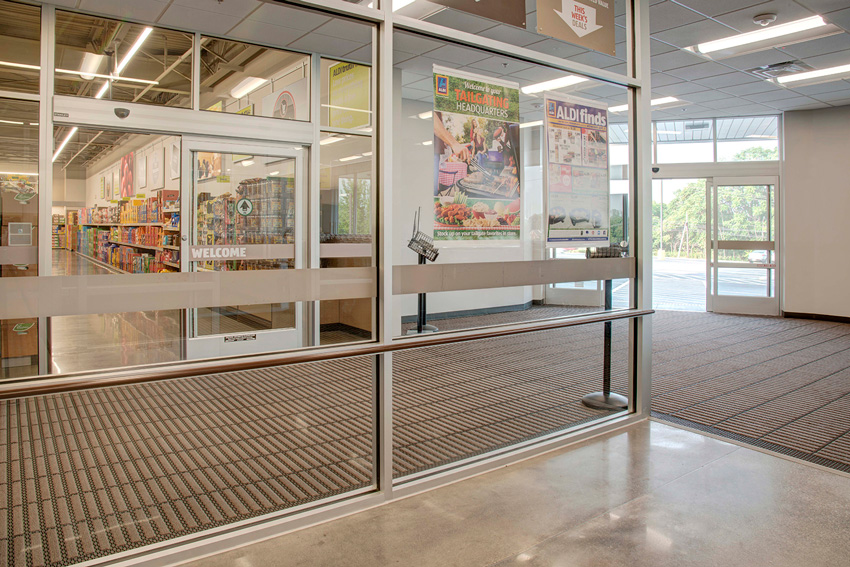
Photo courtesy of Construction Specialties
Modular, interlocking, entrance flooring tiles with integral scrapers and carpet strips provide a safer, cleaner, and more attractive floor area at retail and hospitality entrances.
Gina Van Tine, AIA, LEED AP, of inForm Studios, finds that this type of modular entrance flooring works well for the firm’s projects, saying, “It gives us the assurance that our clients look for to help them maintain a clean sales floor even in the worst weather winter can dish up.” A growing grocery store chain concurs with this assessment. The store finds it to be an easy-to-install solution that keeps its busy interior floors clean and creates the right first impression for guests when they walk in through the doors. In fact, the store has coordinated a prestocking program that made ordering entrance flooring for the continuous store expansions and renovations a quick and simple process.
Effective Cooling and Heating Systems
Providing a comfortable environment in retail and hospitality facilities keeps occupants happy and can lead to increased time spent in the facilities, which is what the business owners want. Of course, they also want that comfort to come with low energy costs and flexibility in the way the system is designed and installed. Fortunately, there is a proven technology to meet all of these needs in the form of variable refrigerant flow (VRF) systems. When incorporated properly, VRF systems give retail and hospitality facilities highly efficient HVAC performance and provide occupants with exceptional comfort without it costing more. In fact, such systems can even save owners money through high energy efficiency, better control, and low maintenance.
Architects have occasionally faced resistance from building owners on these systems due to the owner’s lack of experience with or knowledge of VRF and the misperception that VRF is more costly. Therefore, it often becomes incumbent on the architects and engineers to help educate owners on the reasons to consider VRF, particularly in retail and hospitality spaces. The good news is that VRF has been in use globally for more than 35 years and is continuing to gain popularity in the United States because of the efficiency advantages and the ability to provide personalized comfort to occupants of many different building types. The flexibility of VRF systems allows building owners and architects to design spaces without having to compromise around the layout of a mechanical system.
Among the points to consider are the following:
- VRF is easier to design since it does not require long runs of ductwork and eliminates the need for large mechanical spaces.
- Compact outdoor equipment is easily transported in freight elevators, potentially eliminating the cost of cranes.
- VRF systems require minimal maintenance.
- Energy efficiency significantly reduces utility costs.
- VRF equipment typically lasts up to 20 years, reducing the expense of replacement.
- Space-zoning provides building occupants the ability to personalize their comfort, providing them with a very responsive thermal environment.
- Space-zoning capabilities also give building owners and facility managers the ability to turn off or set back systems in areas that are not occupied, further increasing savings.
- Life-cycle costs for VRF systems are also lower than generally thought. Ease of design and installation, minimal required maintenance, superior energy efficiency and long-lasting equipment contribute significant savings over the life of the system.
These savings and advantages are achieved through the basic engineering technology of the system that is energy efficient and flexible, helping retail and hospitality facilities meet their varied cooling and heating needs. Rather than inefficiently moving conditioned air to the spaces to be treated, VRF delivers refrigerant directly to those spaces and conditions the air within the space, providing better temperature control and the ability to treat zones independently.
VRF can also provide simultaneous cooling and heating from a single two-pipe system. Performance is further improved with inverter-compressor technology that uses the absolute minimum energy necessary to maintain comfort levels while adjusting to partial-load conditions, which are often the predominant state. Rather than inefficiently cycling on and off, VRF systems vary their speed to meet each zone’s conditioning requirements. Additional features like occupancy sensors and the ability to turn off areas that are not in use help further improve energy efficiency.

Photos courtesy of Mitsubishi Electric Cooling & Heating
Variable Refrigerant Flow (VRF) cooling and heating systems are ideal solutions for many retail and hospitality locations for both public and back of house spaces.
In addition to efficiently maintaining comfort, VRF systems provide some other notable design and performance benefits.
- Quiet operation: VRF technology uses compressors that quietly ramp up or down depending on the conditioning needs of each zone, thus eliminating the noisy on-and-off cycle of traditional HVAC systems. Indoor units minimize noise disruption by operating at low sound levels. Check manufacturers’ information, however, since noise levels can vary. Some of the best operate as low as 22 decibels (dBA) indoors with outdoor units operating as quietly at 56 dBA.
- Visually discreet: VRF systems are space-efficient and come in a variety of styles to blend into indoor and outdoor environments.
- Space saving: Compact system footprints give more usable space back to the building design, such as rooftop pools or social areas. No large runs of ductwork are needed, providing the option to increase ceiling height, add larger windows, or even fit additional floors within the same building envelope. Further, no large mechanical rooms are required, giving back more usable square footage for potential income generation.
- Design and system flexibility: Eliminating the need for bulky runs of ductwork makes VRF systems easier to design and modify as needed. Running piping for refrigerant is much more easily incorporated into designs for new or existing buildings. And if changes in the building are needed over time, it is similarly easy to modify or reconfigure systems or even to turn off sections in unoccupied spaces.
Overall, VRF systems are energy efficient and flexible, helping retail and hospitality facilities meet their varied cooling and heating needs. Kevin Miskewicz, director of commercial marketing at Mitsubishi Electric Cooling & Heating, has seen this first hand and points out, “VRF systems provide many benefits to building owners and occupants from personalized comfort to efficiency that significantly reduces energy consumption—and cost—over the life of the system. For architects, system flexibility gives them the freedom to design buildings to their vision without worrying about HVAC constraints.”
Conclusion
Retail and hospitality facilities need to be well designed in order to function well, look appealing to customers, provide comfort, and hold up against heavy use and even abuse. Achieving all of these objectives requires attention to the use of products, materials, and systems that can come together in design and performance in order to be successful. Using some or all of the strategies described in this article can help architects and designers achieve that success while owners and operators reap the long-term benefits.
Peter J. Arsenault, FAIA, NCARB, LEED AP, is a nationally known architect, consultant continuing education presenter, and prolific author advancing building performance through better design. www.pjaarch.com, www.linkedin.com/in/pjaarch





